ESP AUDI R8 SPYDER 2012 Repair Manual
[x] Cancel search | Manufacturer: AUDI, Model Year: 2012, Model line: R8 SPYDER, Model: AUDI R8 SPYDER 2012Pages: 236, PDF Size: 59.24 MB
Page 189 of 236
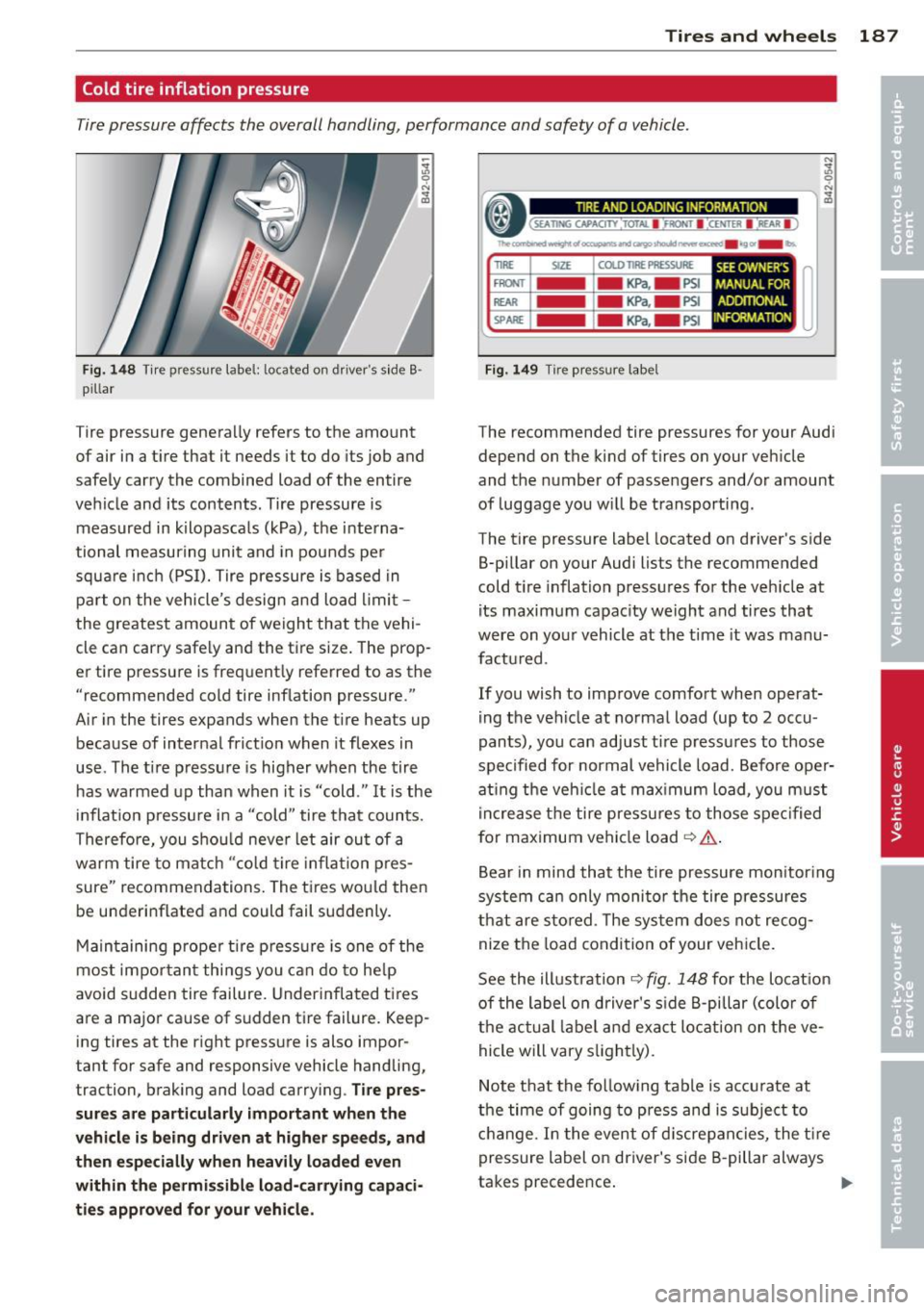
Tires and wheels 187
Cold tire inflation pressure
Tire pressure affects the overall handling , performance and safety of a vehicle .
Fig . 1 48 Tir e pr essur e la b el: located on drive r's s ide B ·
p ill ar
Tire pressu re genera lly refers to the amount
of air in a t ire tha t it needs it to do its job and
safely carry the combined load of the entire
vehicle and its contents . Tire pressure is
measured in kilopasca ls (kPa), the i nterna
tional measuring unit and in pounds pe r
square inc h (PSI). Tire pressure is based in
p ar t o n the vehicle's desig n an d load limit
the greatest amount of weight that the vehi
cle can carry safe ly and the ti re size . The prop
er tire pressure is freq uent ly referred to as the
"recommended cold tire inf lation pressure ."
Air in the tires expands when the tire heats up
because of interna l frict io n when it flexes in
use . The ti re p ressu re is higher when the tire
has warmed up than when it is "cold ." It is the
i nflat io n pressure i n a "cold" tire that counts.
Therefo re, you s ho ul d never let air ou t of a
warm tire to matc h "cold tire infla tion p res
sure" recommendations . The tires wo uld then
be underinf lated a nd could fail suddenly.
M ain taining proper t ire press ure is one of the
most impor tan t thi ngs you c an do to he lp
avoid sudden tire failure. Underinfla ted tires
are a major cause of s udden tire failure . Keep
ing tires at the r ight pressure is also impor
tant for safe and responsive vehicle handling,
traction, b rak ing and load carrying .
Tire pres
sures are particularly important wh en th e
vehicle is being driven at higher speeds , and
then especially when heavily loaded even
within the permi ssible load -carrying capaci
ties approved for your vehi cle.
"' ..,
-~ --------------- ~ a ;l!; TIRE AND LOADING INFORMATION
• (SfATING CAPAOTY JOTAI. I }ROHT I :CUITTR I :R£AR I)
l'hl!o combned~c:loo:upain.sanoatg0,sbo&AdnM'fexeeC1 •"'.gcw -b.
COI.O TIRE PRESSURE
- KPa.- PSI
- KPa,- PSI
_ KPa,. PSI
Fig. 149 Tir e p ressure label
SEE OWNER'S
MANUA L FOR
ADDITTONAL
INFOl
u
The recommended tire pressures for your Audi
depe nd on the ki nd of tires on your ve hicle
and t he number of passe ngers and/or amount
of luggage you w ill be t ransporting .
The t ire pressure label located on driver's side
B-pillar on your Audi lists the recommended
cold t ire inflation pressu res for the veh icle at
its maximum capac ity weight and ti res that
were on yo ur vehicle at the time it was manu
factu red.
If you wish to improve comfort when operat
i ng the vehicle at normal load (up to 2 occu
pants), yo u can adjust ti re pressu res to those
specified for normal vehicle load. Befo re ope r
at ing the veh icle a t max imum load, you must
incr ease t he tire pressures to those spe cified
f or maximum vehi cle load
Q .& .
Bear in mind that the tire pressure mon itor ing
system ca n only moni to r the tire pressures
that are sto red. The sys tem does not recog
nize the load condi tion of your veh icle.
See the illustration
9 fig. 148 fo r the lo cat io n
of the label o n driver's s ide B-pillar (color o f
the actu al la bel a nd exa ct lo cat ion on t he ve
hicle will vary s ligh tly) .
Note t hat the follow ing table is acc urate at
the time of going to press and is s ubject to
c h ange. In the event of d iscre pan cies, the t ire
pressure label on driver's si de B- pillar always
ta kes precede nce . ..,.
Page 190 of 236

188 Tire s and wheel s
The table below lists the recommended cold
tire inflation pressures for the Audi model
covered by your Owner's Literature at the vehi- cle's capacity weight and the ti
re sizes instal
led on the respective models as original
equipment, or as a factory option.
Engine
(dis
place
ment in Tire designation
Tire pressure front Tire pressure rear
normal load full load normal load full load condition condition condition condition
liter )
a -cylin
der
4 .2
inder
5.2 235
/3 5 R1 9 9 1 V
XL
295 /30 R19 100V X L
305 /30 R1 9 10 2V X L
235 /35 R19 91 V X L
295 /30 R1 9 100V XL
305 /30 R19 102V X L
XL= reinfor ced
PSI
45
Because tec hnical changes may be made to
vehicle equ ipment dur ing the model yea r, al
ways compare the tire size designation on the
tire pressure labe l on you r vehi cle w it h the
tires on your vehicle. Ma ke s ure that the ti re
size information on the veh icle label is the
same as the size of the tires on the vehicle.
This is especially important if the vehicle be
longs to someone else or you bought the vehi
cle with different rims/tires or you bought the
vehicle as a previously owned vehicle.
Remember, your safety and that of your pas
sengers also depends on mak ing sure that
load limits are not exceeded. Vehicle load in
cludes everybody and everything in and on the
vehicle . These load lim its are technically refer
red to as the vehicle's G ross Vehicle We ight
Rati ng ("GVWR"). The G ross Ax le Weight Rat
i ng ("GAWR") is the max imum load that can
be app lied at each o f the veh icle's two axles.
The G ross Vehicle Weight Rating and the
Gross Axle Weight Rating are listed on the
safety compliance stic ker labe l located either
on the driver's side B-pillar. The tire pressure
labe l on your Audi lists the maximum com
b ined weight of all of the occupants and lug
gage or other cargo that the veh icle can carry.
For the location of the tire pressure label
¢ fig. 148.
kPA PSI kPA PSI
310 45 310
41
41
kPA PSI
280 41
280 41
kPA
280
280
280
280
.&_ WARNING
Overloading a vehicle can cause loss o f ve
h icle cont ro l, a crash o r other accident, se
r ious pe rsonal injury, and even death.
- Ca rrying more we igh t than your veh icle
was designed to car ry wi ll prevent the
vehicle from handling properly and in
crease the risk of a loss of vehicle con
trol.
- The brakes on a vehicle that has been
overloaded may not be able to stop the
veh icle w ith in a safe distance.
- Tires on a vehicle that has been over load
ed can fail s uddenly caus ing loss of con
trol and a crash.
.&_ WARNING
- Incorrect tire pressures and/or underin
flation can lead to a serious or fatal acci
dent.
- Inco rrect tire pressures and/or underin
f lation cause increased tire wear and can
affect the handling of the vehicle.
- Inco rrect tire pressures and/or underin
f lation can a lso lead to s udden t ire fail
ure, including a blowout and sudden de
fl ation, ca using loss of veh icle cont ro l.
Page 191 of 236
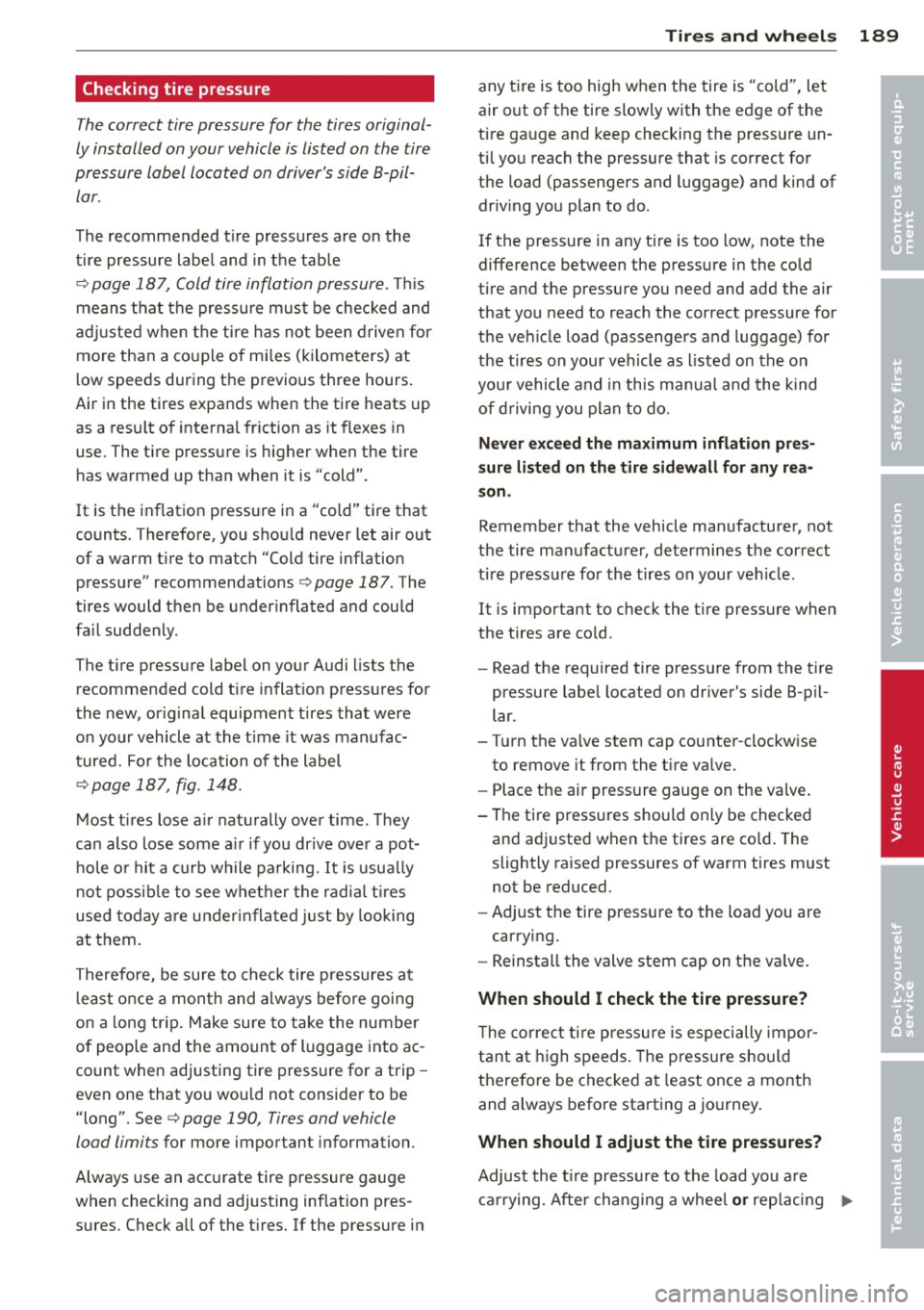
Checking tire pressure
The correct tire pressure for the tires original
ly installed on your vehicle is listed on the tire
pressure label located on driver's side 8-pil lar.
The recommended t ire pressures are on the
tire pressure label and in the table
r:=> page 187, Cold tire inflation pressure . T his
means that the pressure must be checked and
a d ju sted when the tire has not been driven for
mo re than a couple of mi les (kilometers) at
l ow speeds during the p revious three hours.
Air in the tires expands when the tire heats up
as a result of internal fr iction as it flexes in
use. The tire pressure is higher when the tire
h as warmed up than when it is "cold".
It is the inflation pressure in a "cold" tire that
counts. Therefore, you shou ld never let air out
of a warm tire to match "Cold tire inflation pressure" recommendations
c> page 187. The
tires would then be under infla ted and could
fa il suddenly.
The tire pressure label on yo ur Audi lists t he
recommended cold t ire inflat io n pressures for
the new, or igina l equipment tires that were
on your vehicle at the t ime it was manufac
tured. For the location of the label
r=> page 187, fig. 148.
Most tires lose a ir natu rally over time. They
can also lose some a ir if you dr ive ove r a pot
h ole o r hit a curb while pa rking.
It is usua lly
n ot poss ib le to see whe ther the radial t ires
used today a re underi nflated just by looking
at them.
Therefore, be sure to check tire pressures at
l east o nce a month and always before going
on a long trip. Make sure to take the number
of people and the amount of luggage into ac
count when adjusting tire pressure for a trip -
even one that you would not consider to be
"long". See r:=>page 190, Tires and vehicle
load limits for more important information.
Always use an accurate tire pressure gauge
when check ing and adjusting inflation pres
sures . Check all of the t ires. If the pressure in
Tire s an d wheel s 189
any tire is too high when the tire is "cold", let
air out of the tire slowly with the edge of the
tire ga uge and keep checking the pressure un
ti l yo u reach the pressure that is correct for
the load (passengers and luggage) and kind of
driv ing you plan to do .
If the pressure in any ti re is too low, note the
difference between the pressure in the cold
tire and the pressure you need and add the air
that you need to reach the correct pressure for
t h e ve hicle load (passenge rs and luggage) for
the tires on your vehicle as l isted on the on
you r vehicle and in this ma nual a nd the k ind
of d riving you plan to do.
Never ex ceed the max imum inflation pres
sure listed on the tire sidewall for any rea
s on.
Remember that the vehicle manufacturer, not
t h e tire manu factu rer, determines t he correct
ti re p ressu re fo r th e tires on your ve hicl e.
It is important to check the t ire pressure when
the tires are co ld .
- Read the required tire pressure from the t ire
pressure labe l located on drive r's side B-pil
lar.
- T urn the va lve stem cap counter-clockw ise
to remove it from the tire va lve.
- Place the air pressure gauge on the valve.
- The tire pressures should o nly be checked
and ad justed when the tires are co ld . The
slightly raised pressures of warm tires must
not be reduced.
- Adj ust the tire pressure to the load you are
carrying.
- Reinstall the valve stem cap on the va lve.
When should I check the tire pr essu re?
T he co rrect ti re pressu re is especially impor
t a nt a t high speeds. The pressure should
therefore be checked at least once a month
and always before starting a jo urney .
When should I adjust the tire pressures ?
Adjust the tire pressure to the load you a re
ca rrying. After chang ing a whee l
or replacing .,..
•
•
Page 192 of 236
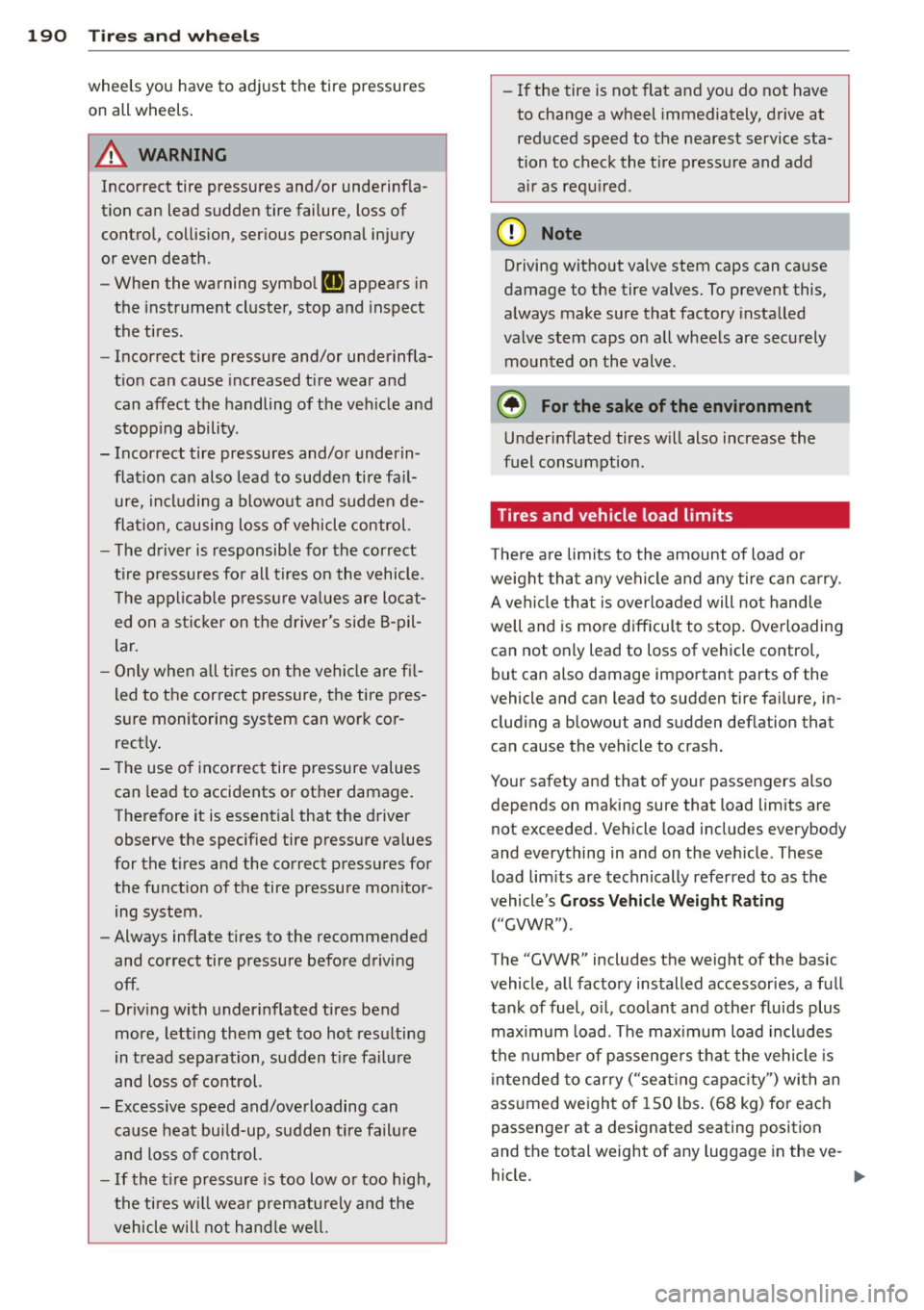
190 Tire s and wheel s
wheels you have to adjust t he tire pressures
on all w heels .
A WARNING
Incorrec t tire pressures and/or underinfla
t ion can lea d sudden tire failure, loss of
contro l, collision, ser ious personal injury
or even death.
- When the warning symbo l
RI] appears in
the instrument cluster, stop and inspect
the tires .
- Incorrect tire pressure and/or underinfla
t io n can cause increased t ire wear and
can affect the handling of the ve hicle and
stopp ing ability .
- Incorrect tire pressures and/or underin fla tion can also lead to sudden tire fa il
ure, incl uding a blowo ut and sudden de
fla tion, causing loss of vehicle control.
- T he d river is responsible for the cor rect
t ire pressures fo r all tires on the vehicle .
T he ap plic a b le p ress ure v alues are locat
ed on a st ic ker on the drive r's side 8-pil
lar.
- O nly when all t ires on the vehi cle ar e fi l
led to the correct pressure, the tire pres
sure monitoring system can wor k co r
rect ly .
- Th e use of incorrect tire pressure values
can lead to accidents or other damage.
Therefore it is essential that the driver
observe the specif ied tire pressure va lues
for the tires and the correct pressures for
the funct ion of the tire pressure mo nitor
ing system .
- Always inflate tires to the recommended
and correct tire pressure befo re drivi ng
off .
- Driv ing with under inflated tires bend
more, lett ing them get too ho t res ulting
in t read separation, sudden t ire fail ure
and loss of control.
- Excess ive speed and/ove rloading can
cause heat bui ld-up, sudden t ire fa ilu re
and loss of control.
- If the t ire pressur e is too low or too high,
the ti res w ill wea r pre matu rely a nd the
vehicle will not h and le we ll. -
If the tire is not flat and you do not have
to change a wheel immediately, drive at
red uced speed to the nearest service sta
tion to check the t ire pressure and add
air as req uired.
(D Note
Driving without valve stem caps can ca use
damage to the tire valves. To prevent this,
a lways make sure that factory installed
valve stem caps o n all whee ls are sec urely
mounted o n the valve.
@ For the sake of the environment
Underinflated tires w ill also increase the
fuel consum ptio n.
Tires and vehicle load limits
T he re a re lim its to the amount of load o r
weight tha t any veh icle a nd any tire can ca rry .
A vehi cle that is overloaded will no t handle
well and is mo re d iff icu lt to stop . Ove rloading
can not only lead to loss of vehicle control,
but can also damage important parts of the
vehicle and can lead to sudden tire fa ilure, in
clud ing a b lowout and sudden deflation that
can cause the vehicle to cras h.
Your safety and that of your passengers also depends on making sure that load limits are
not exceeded. Vehicle load includes everybody
and everything in and on the veh icle . These
load lim its are technically referred to as the
vehicle 's
Gro ss Vehicle Weight Rating
("GVWR").
The "GVWR" includes the weight of the basic
vehicle, all facto ry installed accessor ies, a full
tank of fuel, o il, coolant and other fluids plus
max imum load . T he max imum load includes
t h e nu mbe r of p assenge rs t hat the vehicle is
i n tended to c arry ("seat ing c apac ity") wi th an
ass umed we ight of 150 lbs . (68 kg) for each
passenger at a designated seating position
and the total weight of any luggage in the ve -
hicle. ..,_
Page 195 of 236
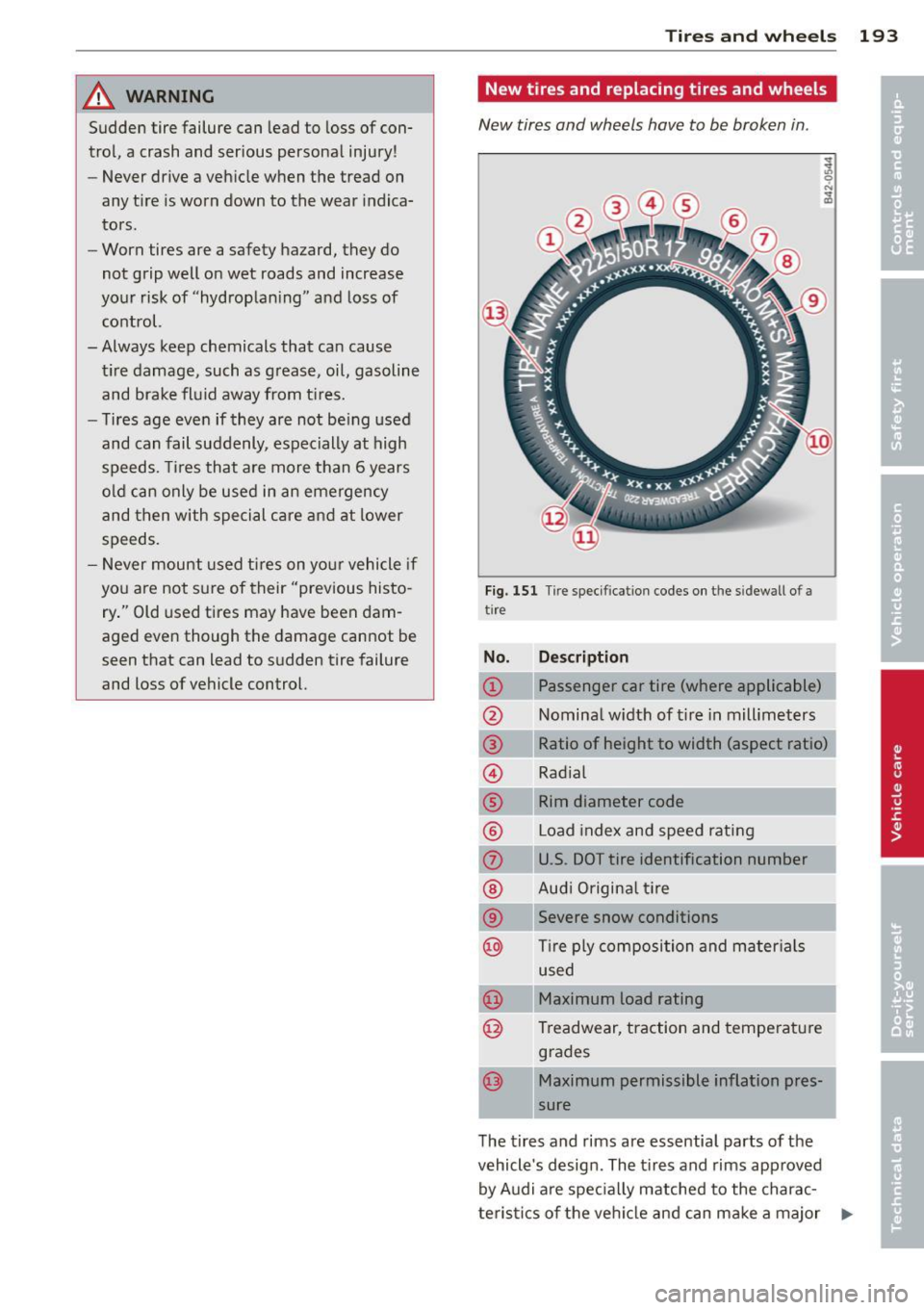
A WARNING
Sudden tire failure can lead to loss of con
trol, a crash and serious personal injury !
- Never drive a vehicle when the tread on
any tire is worn down to the wear indica
tors.
- Worn tires are a safety hazard, they do
not grip well on wet roads and increase
your risk of "hydroplaning " and loss of
control.
- Always keep chemicals that can cause tire damage, such as grease, oil, gasoline
and brake fluid away from t ires.
- Tires age even if they are not be ing used
and can fail suddenly, especially at high
speeds . Tir es that are more than 6 years
old can only be used in an emergency
and then with special care and at lower
speeds.
- Never mount used tires on your vehicle if
you are not sure of their" previous histo
ry ." Old used tires may have been dam
aged even though the damage cannot be
seen that can lead to sudden tire failure
and loss of vehicle control.
Tires and wheels 193
New tires and replacing tires and wheels
New tires and wheels have to be broken in .
Fig. 151 Tir e specifica tion codes on t he s idew all o f a
t ir e
No. Description
CD Passenger car tire (where applicable)
@ Nominal w idth of tire in millimeters
® Ratio of height to width (aspect ratio)
© Radial
® Rim diameter code
® Load index and speed rating
(f) U.S . DOT tire identification number
® Audi Origina l tire
® Severe snow conditions
@ T ire ply composition and materials
used
@ Maximum load rating
@ Treadwear, traction and temperature
grades
@ Maximum permissible inflation pres-
sure
The tires and rims are essential parts of the
vehicle's design . The tires and rims approved
by Audi are spec ially matched to the charac
teristics of the vehicle and can make a major .,.
•
Page 199 of 236
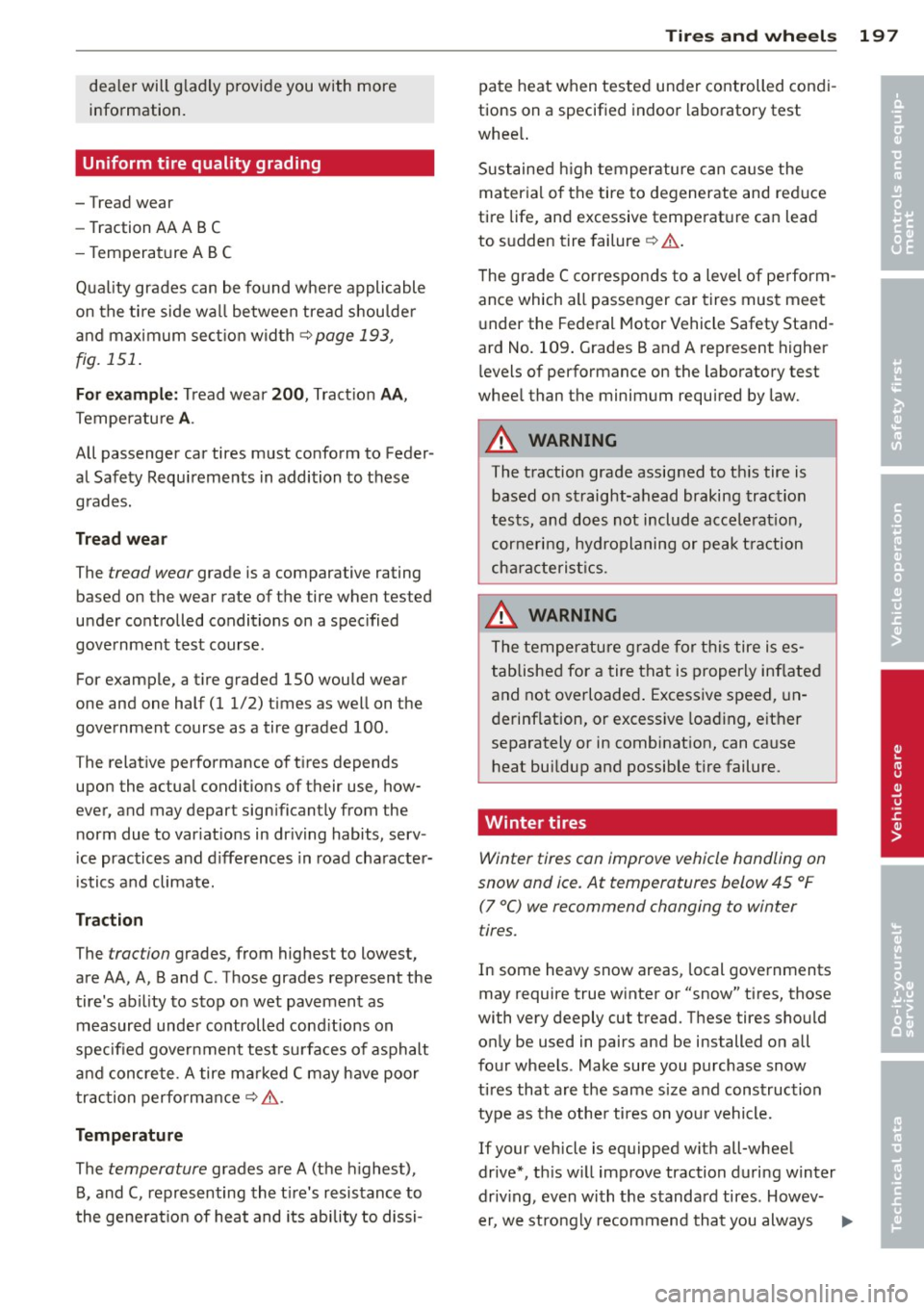
dealer will g ladly provide you with more
information.
Uniform tire quality grading
- Tread wear
- Traction AA A B C
- T emperature ABC
Quality grades can be found where applicable
on the ti re side wa ll between tread shoulde r
and maximum section wid th ¢ page 193,
fig. 151 .
For example : Tread wear 200, Tract ion AA ,
Temperatu re A .
All passenger car tires must conform to Feder
al Safety Requi rements in addition to these
grad es.
Tread we ar
The tread wear grade is a comparative rating
based on the wear rate of the tire when tested
under controlled conditions on a spec ified
government test course .
For example, a t ire graded 150 would wear
one and one half (1 1/2) t imes as well on the
government course as a tire graded 100 .
The relat ive perform a nee of ti res depends
upon the actua l conditions of their use, how
ever, and may depart sign ificantly from the
norm due to var iat ions in dr iv ing habits, serv
i ce practices and differences in road character
i stics and climate.
Traction
The traction grades, from highest to lowest,
are AA, A, B and
C. Those grades represent the
tire's abil ity to stop on wet pavement as
measured unde r controlled cond it ions on
spec ified gove rnment test su rfaces of asphalt
and concrete . A tire ma rked C may h ave po or
t ra ction perfo rm ance¢ &..
Temp erature
The temperature grades are A (the h ighest),
B, and C, repr ese nting the t ire's resistance to
the gene rat io n of heat and its ab ility to dissi-
Tire s an d wheel s 197
pate heat when tested under controlled condi
tions on a specified indoor laboratory test
whee l.
Sustaine d high temperature can cause the
mater ia l of the tire to degenerate and red uce
tire life, and excessive tempe rat ure ca n lead
to s udden tire failure ¢ &. .
T he gr ade C correspon ds to a level of pe rform
ance which all passenger car tires must meet u nder the Federal Motor Vehicle Safety Stand
ard No . 109 . Grades Band A represent higher
l evels of performance on the laboratory test
whee l than the minimum requ ired by law.
A WARNING
The traction grade assigned to th is tire is
based on straight-ahead braking traction
tests, and does not include accele rat ion,
cor neri ng, hy droplaning or peak t ra ction
ch aracte rist ics.
A WARNING
T he temperature grade for this tire is es
tablishe d for a tire that is properly inf lated
and not overloaded . Excess ive speed, un
derinflation, or excessive loading, e it h er
separately or in combinat ion, can ca use
heat bui ldup and possible tire failure.
Winter tires
Winter tires can improve vehicle handling on
snow and ice. At temperatures below 45 °F (7 °C) we recommend changing to winter
tires.
In some heavy snow areas, local governments
may require true w inter or "snow" tires, those
with very deeply cut tread. T hese tires should
o nl y be used in pairs and be installed o n all
fou r wheels . Make sure you purchase snow
ti res that a re the same si ze and construction
type as the othe r ti res on you r vehicle.
If your vehicle is equipped w ith all-whee l
drive*, th is w ill improve traction during winter
driv ing, even with the s tanda rd tires . Howev-
er, we stro ngly recommend that you always ..,.
•
•
Page 202 of 236
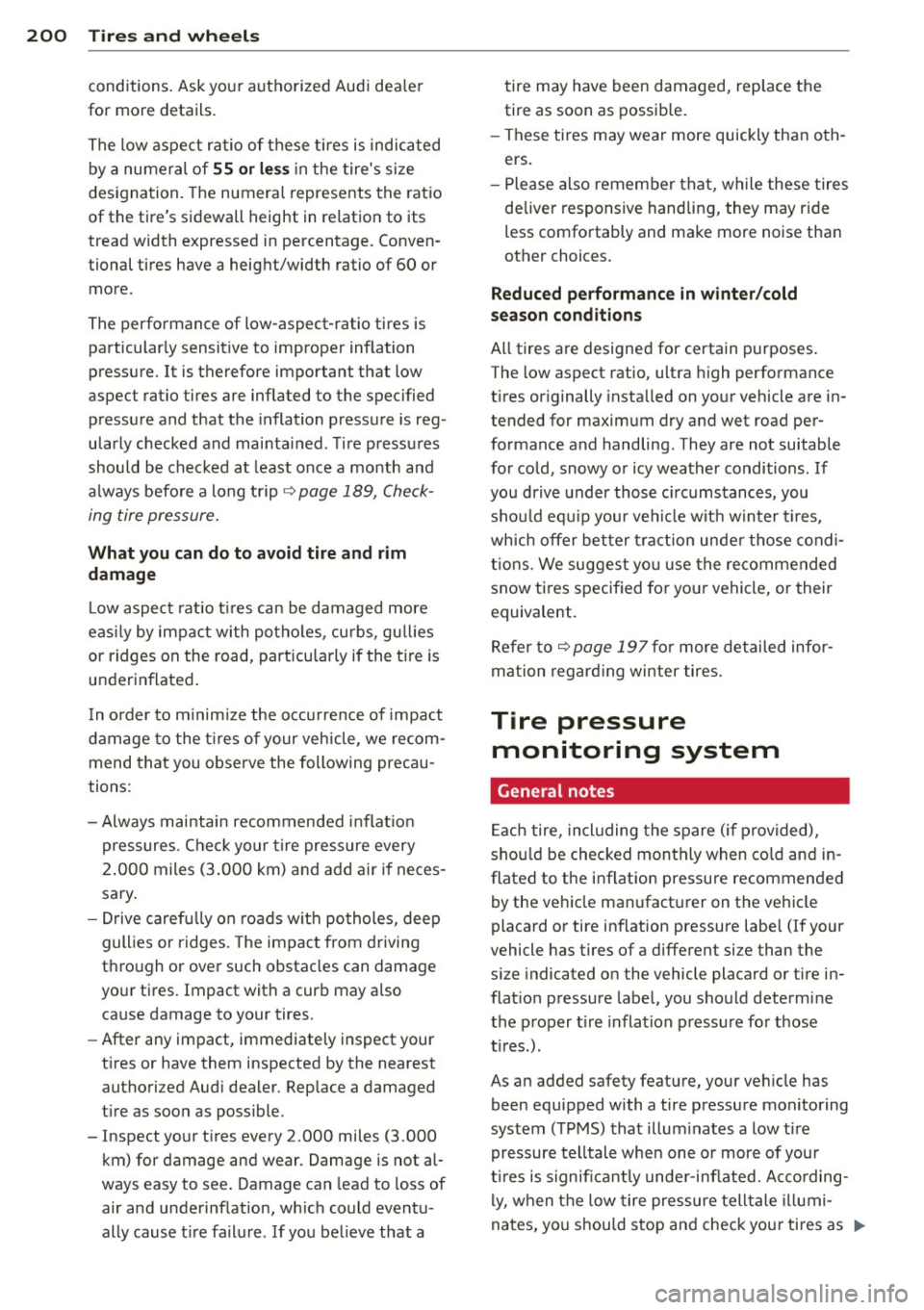
200 Tires and wheels
conditions. Ask your authorized Audi dea ler
for more details.
The low aspect ratio of these tires is indicated
by a numeral of 55 or less in the tire's size
designation. The numera l represents the ratio
of the tire's sidewall height in relation to its
tread width expressed in percentage. Conven
tional tires have a height/width ratio of 60 or
more.
The performance of low-aspect -ratio tires is
particularly sensitive to improper inflation
pressure. It is therefore important that low
aspect ratio tires are inflated to the specified
pressure and that the inflation pressure is reg
ularly checked and maintai ned. Tire pressures
should be checked at least once a month and
a lways befo re a long t rip
~ page 189, Check
ing tire pressure.
What you can do to avoid tire and rim
damage
L ow aspect ratio tires can be damaged more
eas ily by impact with potholes, curbs, gullies
o r ridge5 on the road, particu larly if the tire i5
underinflated.
I n order to minimize the occurrence of impact
damage to the tires of your vehicle, we recom
mend that you observe the following precau
tions:
- Always maintain recommended inflation
pressures. Check your tire pressure every
2.000 miles (3.000 km) and add air if neces
sary .
- Drive carefully on roads with potholes, deep
gullies or ridges. The impact from driving
through or over such obstacles can damage
your tires. Impact with a curb may also cause damage to your tires.
- After any impact, immediately inspect your
tires or have them inspected by the nearest
authori zed Aud i dealer. Rep lace a damaged
t ir e as soon as possible.
- Inspect your tires every 2.000 miles (3.000 km) for damage and wear . Damage is not al
ways easy to see. Damage can lead to loss of
air and underinflation, wh ich could eventu
ally cause t ire failure . If you believe that a tire
may have been damaged, rep lace the
tire as soon as possible.
- These tires may wear more quickly than oth
ers.
- Please also remember that, while these tires
delive r responsive handling, they may ride
less comfortably and make more noise than
other choices .
Reduced performance in winter/cold
season conditions
All tires are designed for certain purposes.
The low aspect ratio, ultra high performance
t ir es or iginally installed on your vehicle are in
tended for maximum dry and wet road per
formance and handling . T hey are not suitable
for cold, snowy or icy weather conditions . If
you drive under those c ircumstances, you
should equ ip your vehicle with winter tires,
which offer better traction under those condi
tions . We suggest yo u use the recommended
snow tires specified for your vehicle, or their
equivalent.
Refer to~
poge 197 for more detailed infor
mation regarding winter tires.
Ti re pressure
monitoring system
General notes
Eac h tire, including the spare (if provided),
shou ld be checked mon thly when cold and in
flated to the inflat ion pressure recommended
by the ve hicle manufacturer on the vehicle
placard or tire inflation pressure labe l (If your
vehicle has tires of a different si ze than the
s ize indicated on the vehicle placard or tire in
flat ion pressure label, you should determine
the proper t ire in flation pressure for those
t ir es .) .
As an added safety feature, your vehicle has been equipped with a tire pressure monitoring
system (TPMS) that illum inates a low tire
pressure telltale when one or more of your
tires is significantly under-inflated. Acco rding
ly, when the low tire pressure telltale illumi
nates, you shou ld stop and check you r tires as
Ill>-
Page 203 of 236
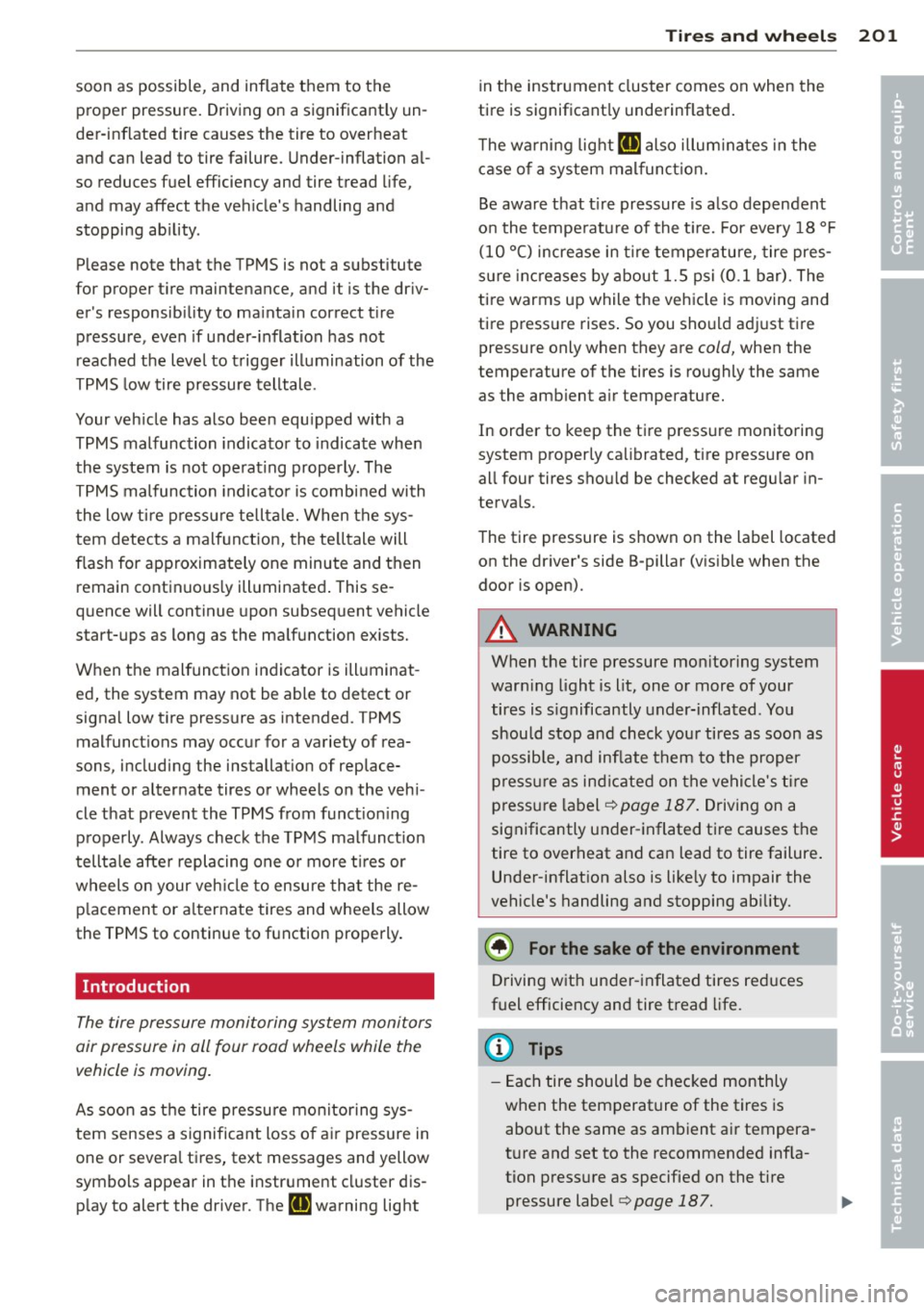
soon as possible, and inflate them to the
proper pressure . Driving on a significant ly un
der-inflated tire causes the tire to overheat
and can lead to tire failure. Under-inflation a l
so reduces fuel efficiency and tire tread l ife,
and may affect the veh icle 's handling and
stopping ab ility.
Please note that the TPMS is not a substitute
for proper t ire maintenance, and it is the dr iv
er's responsib ility to ma inta in correct t ire
p ress ure , even if under- inflation has not
reached the leve l to t rigger illumination of the
TPMS low tire pressure telltale .
Your veh icle has also been equ ipped with a
TPMS malfunction indicato r to indicate when
the system is not ope rating properly. The
TPMS malfunc tion indica to r i s combined wi th
the low t ire pr essu re tellta le. When the sys
tem detec ts a ma lf u nct ion, the te lltale will
flash for approximately one minute and then remain continuo usly ill uminated . This se
q uence will continue upon subsequent vehicle
start-ups as long as the malfunction ex ists.
When the malfunction indicator is ill uminat
ed, the system may not be able to detect or
signa l low t ire pressure as intended . TPMS
malfunct ions may occ ur for a variety of rea
sons, including the ins talla tio n of replace
ment or a lternate tires o r whee ls on the veh i
cle that prevent the TPMS from funct io ni ng
p roperly . Always check the TPMS malfunct ion
t ellta le afte r replacing one o r more t ires or
wheels o n your veh icle to ensure tha t the re
p lacemen t or a lternate tires and wheels allow
the TPMS to continue to function properly .
Introduction
The tire pressure monitoring system monitors
air pressure in all four road wheels while the
vehicle is moving .
As soon as the tire pressu re mo nitor ing sys
tem senses a s ignificant loss of a ir pressure in
one or severa l ti res, text messages and yellow
symbo ls appear in the instr ument cluster dis
p lay to alert the driver. The
[ti warning light
Tire s an d wheel s 201
in the instrument cluster comes on when the
ti re is significant ly underinflated .
T he wa rni ng lig ht
[ti also illu minates i n the
case of a system mal funct io n.
Be aware that t ire pressure is a lso dependent
o n the tempe ratu re of the t ire. For eve ry 18 ° F
(10 °C) incre ase in tir e te mper ature, tire pres
s u re inc reases by about 1.5 psi (0 .1 bar). The
ti re warms up while the ve hicle is moving and
tire p ress ure rises . So you sho uld ad just tire
pressure only when they a re
cold, when the
temperature of the tires is ro ughly the same
as the ambient a ir temperature.
In order to keep the tire press ure monito ring
system p roperly ca librated, t ire press ure on
all four tires sho uld be checked at regu lar in
terva ls.
The tire pressure is shown on the label located
on the dr iver's side B-pillar (v is ib le when the
door is open) .
A WARNING
When the tire pressure mo nitoring system
war ning light is lit , one o r m ore of your
tires is s ignificantly under-infla ted . You
shou ld stop and check your tires as soon as
pos sib le, and in flate t hem to the proper
p ress ure a s in dic ate d on the ve hicle's ti re
p ress ure lab el
¢page 187. Driving on a
significantly under -inflated ti re causes t he
tire to over heat and can lead to tire failure .
Under-inflat ion also is like ly to impair the
vehicle's handling and stopping ab ility.
@ For the sake of the environment
D riving wit h un der -inflated tires red uces
fuel efficiency an d tire t read life.
(D Tips
- E ach tire should be chec ked monthly
w hen the tem perature of the tires is
about the same as amb ient a ir tempera
t u re and set to the recommended infla
tion press ure as specified on the tire
pressure label¢
page 187.
•
•
Page 220 of 236

218 Data
Dimensions
I
Length (with license plate bracket)
W idth
W idth (across mirrors)
He ight (unloaded)
T ur ning circle diameter (curb to curb) RB Spyder 4.2
quattro
4 434 mm (ap
prox . 174.6 in)
1 9 04 mm (app rox . 7 5. 0
i n)
2029 mm (ap
prox. 80.0 in)
1244 mm (ap
p ro x. 49.0 in)
1 1.80 m (ap
prox . 38. 7
ft)
When dr iv in g up steep ramps, on rough roads,
ove r curbs, e tc. it is impo rt a nt to remembe r
that some parts o f your ve hicl e, such as spoil
e rs or exhaust sys tem components, may be
close to the ground . Be ca reful not to damage
them.
T his applies espe cially to ve hicles w ith a low
chassis (sports chassis) an d when the vehicle
is fully loade d.
Capacities (approx.)
Fuel tank
RB RB
Spyder Spyder
4.2 5 .2
quattro quat- tro
Total capacity ga l/ 21.1/8 21.1/8
li ters
0 0
Reserve (of tota l
gal/ 2 .6/10 2 .6/10
capacity) liters
Windshield washer system Winds hield wash -qua rts app rox. 4.2/4.0
er fluid /liters RB Spyder 5
.2
quattro
4 434 mm (ap
prox. 174.6 in)
190 4 mm (approx. 75. 0 i n)
2029 mm (approx. 80.0 in)
1
1244 mm (approx. 49.0 in)
11.80 m (appro x. 38. 7
ft)
Page 221 of 236
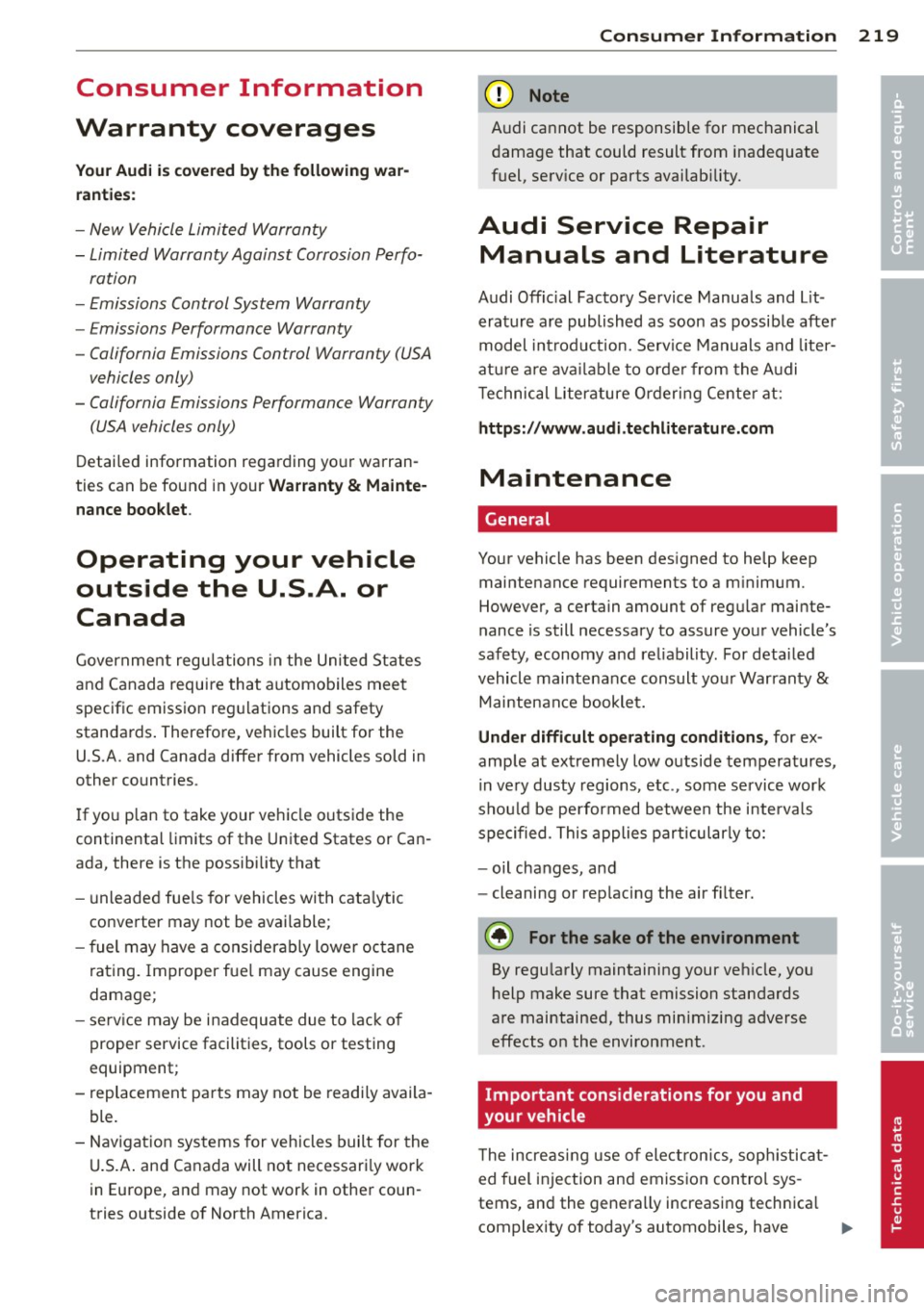
Consumer Information
Warranty coverages
Your Audi is covered by the following war
ranties:
- New Vehicle Limited Warranty
- Limited Warranty Against Corrosion Perfo-
ration
- Emissions Control System Warranty
- Emissions Performance Warranty
- California Emissions Con trol Warranty (USA
vehicles only)
- California Emissions Performance Warranty
(USA vehicles only)
Detailed information regarding your warran
ties can be found in your
Warranty & Mainte
nance booklet .
Operating your vehicle
outside the U.S.A. or
Canada
Government regulations in the United States
and Canada require that automobiles meet
specific emission regulations and safety
standards. Therefore, veh icles built for the
U.S.A. and Canada differ from vehicles sold in
other countries .
If you p lan to take your vehicle outside the
continental limits of the United States or Can
ada, there is the possibility that
- unleaded fuels for vehicles with cata lytic
converter may not be available;
- fuel may have a considerably lower octane
rating . Improper fuel may cause engine
damage ;
- service may be inadequate due to lack of
proper service facilities, tools or testing
equipment ;
- replacement parts may not be readily availa
ble.
- Navigation systems for vehicles built for the
U.S.A. and Canada will not necessari ly work
in Europe, and may not work in other coun
tries outside of North America.
Consumer Information 219
@ Note
Audi cannot be responsible for mechanical
damage that could result from inadequate
fuel, service or parts availability.
Audi Service Repair Manuals and Literature
Audi Offic ial Factory Service Manuals and Lit
erature are published as soon as possible after
model introduction. Service Manuals and liter
atu re are availabl e to order from the Audi
T echnical Literature Ordering Center at:
https: //www.a udi.techliterature.com
Maintenance
' General
Your vehicle has been designed to help keep
maintenance requirements to a minimum.
However, a certain amount of regular mainte
nance is still necessary to assure your vehicle's
safety, economy and rel iability . For detailed
vehicle maintenance consult your Warranty
&
Maintenance booklet.
Under difficult operating conditions, for ex
ample at extremely low outside temperatures,
in very dusty regions, etc., some service work
shou ld be pe rformed between the intervals
specified. This applies particularly to:
- oil changes, and
- cleaning or replacing the air fi lter.
@ For the sake of the environment
By regu larly maintaining your vehicle, you
help make sure that emission standards
are maintained, thus min imizing adverse
effects on the environment.
Important considerations for you and
your vehicle
T he increasing use of electron ics, soph isticat
ed fuel injection and emission control sys
tems, and the generally increasing technica l
complexity of today's automobiles, have ..,_
•
•